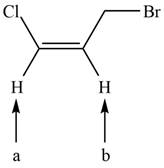
Concept explainers
(a)
Interpretation: The number of peaks present in the given NMR signal of labeled proton is to be calculated.
Concept introduction: In NMR spectrum, peaks are known as resonances, lines or absorptions. The number of NMR signal in a compound is equal to the number of chemically non-equivalent protons present in that compound. In
Answer to Problem 14.17P
The labeled proton splits into septet in NMR spectrum of the given compound.
Explanation of Solution
The given compound is
Where,
➢
➢
Here,
Substitute the value of
Hence, the labeled proton gives seven peaks in NMR spectrum.
The labeled proton splits into septet in NMR spectrum of the given compound.
(b)
Interpretation: The number of peaks present in the given NMR signal of labeled proton is to be calculated.
Concept introduction: In NMR spectrum, peaks are known as resonances, lines or absorptions. The number of NMR signal in a compound is equal to the number of chemically non-equivalent protons present in that compound. In
Answer to Problem 14.17P
The labeled proton (a), (b), and (c) splits into triplet, multiplet and quintet in NMR spectrum of the given compound.
Explanation of Solution
The given compound is
Where,
➢
➢
Here,
Substitute the value of
Hence, the labeled proton (a) gives three peaks (triplet) in NMR spectrum.
Proton (b) is bonded to one methylene group that has two hydrogen atoms and one methyl group that has three hydrogen atoms. The number of peaks is calculated by the formula,
Where,
➢
➢
Here,
Substitute the value of
Hence, the labeled proton (b) splits into a multiplet in NMR spectrum.
Proton (c) is bonded to two methylene groups that have four hydrogen atoms. The number of peaks is calculated by the formula,
Where,
➢
➢
Here,
Substitute the value of
Hence, the labeled proton (c) gives quintet in NMR spectrum.
Therefore, protons (a), (b), and (c) give
The labeled proton (a), (b), and (c) splits into triplet, multiplet and quintet in NMR spectrum of the given compound.
(c)
Interpretation: The number of peaks present in the given NMR signal of labeled proton is to be calculated.
Concept introduction: In NMR spectrum, peaks are known as resonances, lines or absorptions. The number of NMR signal in a compound is equal to the number of chemically non-equivalent protons present in that compound. In
Answer to Problem 14.17P
The labeled proton (a) and (b) splits into doublet and sextet in NMR spectrum of the given compound.
Explanation of Solution
The given compound is shown below.

Figure 1
There are two labeled protons, (a) and (b). Proton (b) is bonded to a carbon atom that has one hydrogen and one methylene group. The number of peaks is calculated by the formula,
Where,
➢
➢
Here,
Substitute the value of
Hence, the labeled proton (b) splits into a sextet in NMR spectrum.
Proton (a) is bonded to a carbon atom that has only one hydrogen atom. The number of peaks is calculated by the formula,
Where,
➢
➢
Here,
Substitute the value of
Hence, the labeled proton (a) gives two peaks (doublet) in NMR spectrum.
Therefore, protons (a) and (b) give
The labeled proton (a) and (b) splits into doublet and sextet in NMR spectrum of the given compound.
(d)
Interpretation: The number of peaks present in the given NMR signal of labeled proton is to be calculated.
Concept introduction: In NMR spectrum, peaks are known as resonances, lines or absorptions. The number of NMR signal in a compound is equal to the number of chemically non-equivalent protons present in that compound. In
Answer to Problem 14.17P
The labeled proton (a) and (b) splits into triplet, doublet and doublet in NMR spectrum of the given compound.
Explanation of Solution
The given compound is shown below.

Figure 2
There are two labeled protons, (a) and (b). Proton (a) is bonded to a carbon atom that has two hydrogen atoms. The number of peaks is calculated by the formula,
Where,
➢
➢
Here,
Substitute the value of
Hence, the labeled proton (a) gives three peaks (triplet) in NMR spectrum.
Both protons (b) are bonded to a carbon atom that has only one hydrogen atom. The number of peaks is calculated by the formula,
Where,
➢
➢
Here,
Substitute the value of
Hence, the labeled protons (b) give two peaks (doublet) in NMR spectrum.
Therefore, protons (a) and (b) give
The labeled proton (a) and (b) splits into triplet, doublet and doublet in NMR spectrum of the given compound.
Want to see more full solutions like this?
Chapter 14 Solutions
ORGANIC CHEMISTRY SOLUTIONS MANUAL
 EBK A SMALL SCALE APPROACH TO ORGANIC LChemistryISBN:9781305446021Author:LampmanPublisher:CENGAGE LEARNING - CONSIGNMENT
EBK A SMALL SCALE APPROACH TO ORGANIC LChemistryISBN:9781305446021Author:LampmanPublisher:CENGAGE LEARNING - CONSIGNMENT
